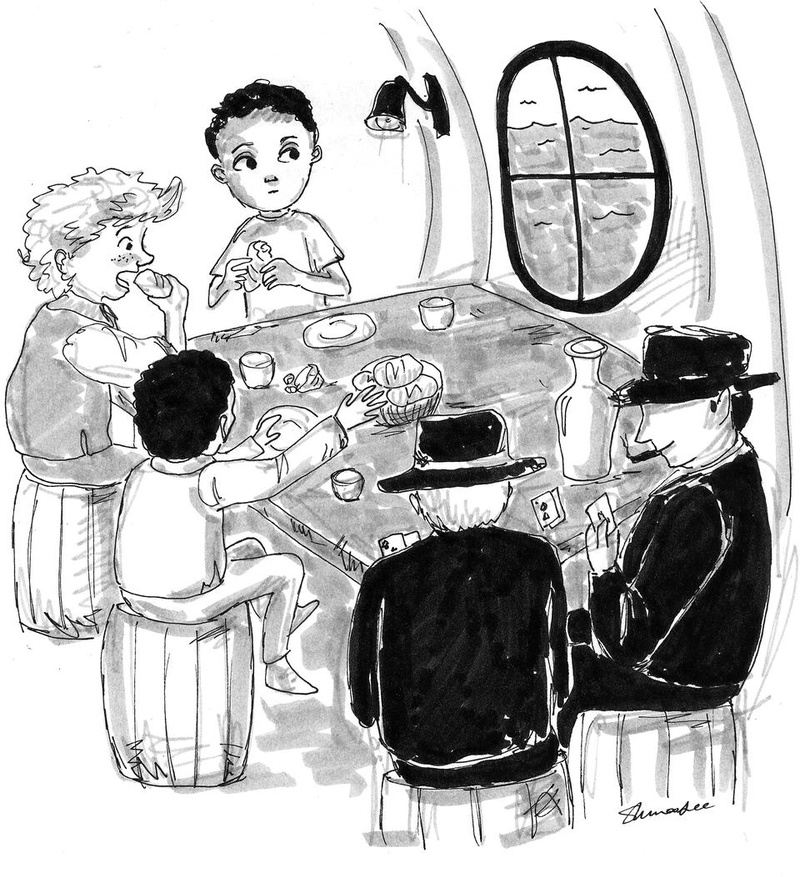As the Oronsay Boat sets sail into the dark ocean in the opening pages of “The Cat’s Table,” so too does author Michael Ondaatje embark into a drifting narrative sea of memory and imagination. His latest novel is a series of embellished memories from a three-week sea voyage. Each carefully arranged fragment conveys the excitement of puberty, feelings of alienation, and the enigmatic nature of personal connections. Narrating childhood memories through an aged voice, the novel poignantly eulogizes the wisdom of perspective and the transcendence of shared experience.
“The Cat’s Table” is a semi-autobiographical novel that recounts the journey of 11-year old “Mynah” from his homeland of Sri Lanka to his new home of England. The narrative follows the boy and his two friends––Cassius and Ramadhin––as they delve through the ship’s rooms, decks, and off-limits zones. The novel retreats from conventional plot development, and instead unravels via discoveries and explorations the boys undertake aboard the ship. Through this unusual structure, “The Cat’s Table” attains a fragmentary and often dislocated quality that poignantly reflects the unreliability of memory.
However, this unusual construction does not carry over to the narrative and language of the novel. Ondaatje’s descriptions are exquisitely detailed and quietly sensual. Each encounter is laced with references to looks, or gestures, or movements. It is easy to become lost in the highly sensitized world of this 11-year-old child. The effect of such sharp language is powerfully visceral: as Mr. Muppazi softly touches Mynah’s face, we almost feel his touch upon our own skin.
The Cat’s Table––from which the novel takes its name––is the self-appropriated term for those least important passengers aboard the ship, all of whom are seated together in the dining hall. A mélange of strangers seated together for the period of the voyage, the narrator lavishes description and attention upon these characters, and each one is surrounded with fabricated tales and stories. Ondaatje adopts the fine detailing of a portrait painter: “You could see her in a deck chair reading crime novels within the rectangles of deep shadow, her bright blond hair a little sparkle in her chosen gloom.” These images, frozen in Mynah’s memory, glimmer with intricate visual details, and the result is a strikingly vivid narrative.
Beginning with concrete images, the narrator inevitably progresses into imagination as the three boys adopt the role of detectives. As the they ramble through the ship, “vacuuming up clues,” they hear snatches of conversation and invent back stories for each member of the Cat’s Table. Miss Lasqueti––a young lady who reads crime novels before throwing them into the ocean––becomes, in the boys’ world, a spy with connections to Whitehall. Mr. Mazappa––the entertaining pianist––disappears at Port Said, supposedly, because of his adulterous relationship with Miss Lasqueti. Each tale is ambiguous, and their details are obfuscated, but this lack of clarity appropriately reflects the experience of the prepubescent investigators. The boys can gather details and pieces of evidence, but their misunderstandings of adult interaction leave their interpretations shadowy and even bizarre.
The experiences of the child, told from an aged perspective, means that the boundaries between memory and imagination, between reality and youthful creativity, are often blurred. Pushing back against the limitations of reality, “The Cat’s Table” emphasizes the human desire to know and understand others around us. This desire is most potently actualized in Mynah’s intimate encounter with his cousin Emily on the voyage. Ondaatje describes the trembling sensation that accompanies a moment of affinity, before the unutterable feeling of loss when the encounter is at an end: “Suddenly there was a wide gulf between Emily’s existence and mine, and I would never be able to cross it.” Even later in life when he meets Emily again, Mynah cannot re-capture this fleeting instant of youthful intimacy. This transient connection is poignant and, indeed, riveting. Moments like these transform the novel into a poetic voyage of self-discovery.
As the novel unfolds, characters and events become increasingly sinister. Criminal activity, muffled shouts at night, and mysterious deaths are all recounted from the perspective of Mynah crouching beneath an upturned lifeboat. The freneticism and absurdity of these events stretch the imagination, and sometimes fit oddly with the subtle imagery and wizened perspective of the novel. Ondaatje emphasizes the collective experience of the passengers aboard the Oronsay, and this negates the potential flaw. His use of the collective consciousness is a dramatic strategy and one of the prime virtues of the novel.
Ondaatje’s focus on the collective experience, as opposed to the events themselves, is apparent in Mynah’s description of the Oronsay entering the Suez Canal. The details are rich and chaotic, and the author eloquently describes trades between the ship and the mainland merchants, exotic goods, fleeting conversations across the water. The narrative goes on to recount an experience later in life when Mynah visits an art exhibit by Cassius––one of his compatriots upon the ship––and recognizes the paintings as representations of their trip down the Suez Canal: “I suppose it clarified how close Cassius and I had been, real brothers. For he also had witnessed the people I saw that night, with whom we had felt so oddly aligned, whom we had never seen again. Only there.”
“The Cat’s Table” is a voyage on multiple levels: it is a physical journey, a voyage of youth to adulthood, and also a journey back into the memory, as the narrator unearths a deeper understanding of his past. What he realizes is profound and significant: he wants intimacy but cannot break down emotional walls, and he recognizes the deep changes that individuals can wreak upon each other’s lives. However, Ondaatje is ultimately more interested in the intimacy of collective experience. These moments of perspective, which recognize even the most fleeting instances of closeness, ultimately allow Ondaatje’s newest effort to triumph.
––Staff writer Sarah L. Hopkinson can be reached at shopkinson@college.harvard.edu.
Read more in Arts
Daughter Reckons with Mother’s Literary Legacy













